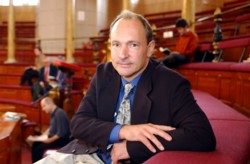Wednesday, November 14, 2012; 14:00-15:30 (Gregorian)
The Semantic Web / Linked Data has grown immensely over the past years. When the Semantic Web community started working over a decade ago the main question was where to get the data from. By now the question of how to process ever increasing amount of semantic/linked data has come to people's utmost attention. The goal of this panel is to shed light on the various approaches/options for Big Graph Data processing. Possible questions include:
- Does the Semantic Web need any central infrastructures? (It's a Web, after all?)
- Or will a handful of large single-owner infrastructures dominate the Semantic Web, just as they now dominate the current Web?
- And if so, will such infrastructures be based on the standard relational model?
- Or on MapReduce-centric key/value-pairs?
- Is Google's (centralised) Knowledge Graph anathema to the Semantic *Web* ?
- Are triplestore vendors just reinventing the old database wheels?
- What is the role of clustered MapReduce-like solutions and where are their limits for processing semantic web data?
To discuss this issue we were fortunate enough to gather an esteemed panel of scientists and practitioners - each having a unique viewpoint on this kind of processing. The panelists will include:
- Tim Berners-Lee, W3C, USA
- John Giannandrea, Google, USA
- Frank van Harmelen, VU, The Netherlands (Moderator)
- Mike Stonebreaker, MIT, USA
- Bryan Thompson, Systap, USA
We believe that the panel will be an exceptional event and am looking forward to an exciting discussion.
The Panelists
|
He is the 3Com Founders Professor of Engineering in the School of Engineering with a joint appointment in the Department of Electrical Engineering and Computer Science at the Laboratory for Computer Science and Artificial Intelligence ( CSAIL) at the Massachusetts Institute of Technology (MIT) where he also heads the Decentralized Information Group (DIG). He is also a Professor in the Electronics and Computer Science Department at the University of Southampton, UK. He is the Director of the World Wide Web Consortium (W3C), a Web standards organization founded in 1994 which develops interoperable technologies (specifications, guidelines, software, and tools) to lead the Web to its full potential. He was a Director of the Web Science Trust (WST) launched in 2009 to promote research and education in Web Science, the multidisciplinary study of humanity connected by technology. Tim is a Director of the World Wide Web Foundation, launched in 2009 to coordinate efforts to further the potential of the Web to benefit humanity. |
|
|
|
|
|
Professor Stonebraker is the author of scores of research papers on data base technology, operating systems and the architecture of system software services. He was awarded the ACM System Software Award in 1992, for his work on INGRES. Additionally, he was awarded the first annual Innovation award by the ACM SIGMOD special interest group in 1994, and was elected to the National Academy of Engineering in 1997. He was awarded the IEEE John Von Neumann award in 2005, and is presently an Adjunct Professor of Computer Science at M.I.T, where he is co-director of the new Intel Science and Technology Center focused on big data. |
|
He believes that web scale graph databases, GPU accelerated graph processing, and Web 2.0 authoring models will make it possible to capture metadata about the relationships between evidence and conclusions within and across communities and offer services and user experiences that encourage and facilitate collaboration across communities when their areas of expertise touch on shared concerns. Mr. Thompson is a National Merit Scholar. He has been recognized for his contributions under the Small Business Innovation Research (SBIR) program and by the Federal Semantic Interoperability Community of Practice (SICoP). He recently presented at the prestigious Schloss Dagstuhl Seminar on Semantic Data Management. He is a past member of the W3C Advisory Committee and participated the standardization efforts for SPARQL 1.0, Web Services Architecture, and XML Topic Maps. |

 A graduate of Oxford University,
A graduate of Oxford University, 


